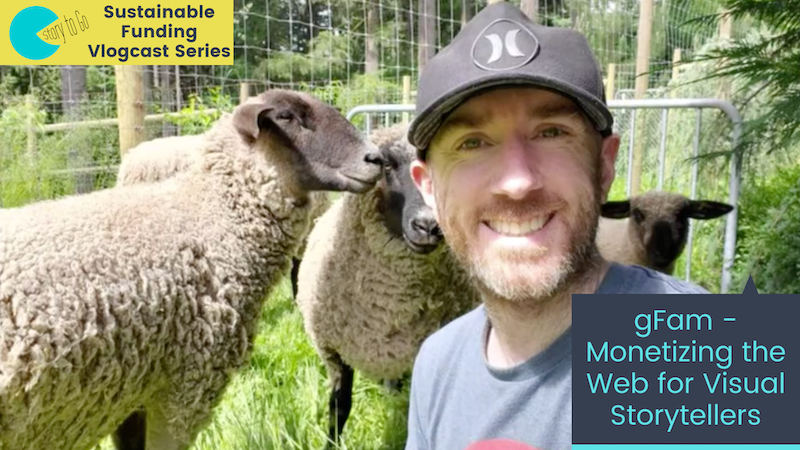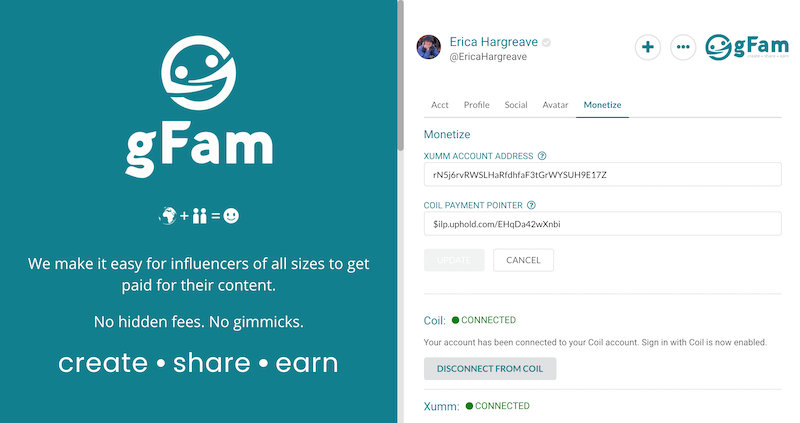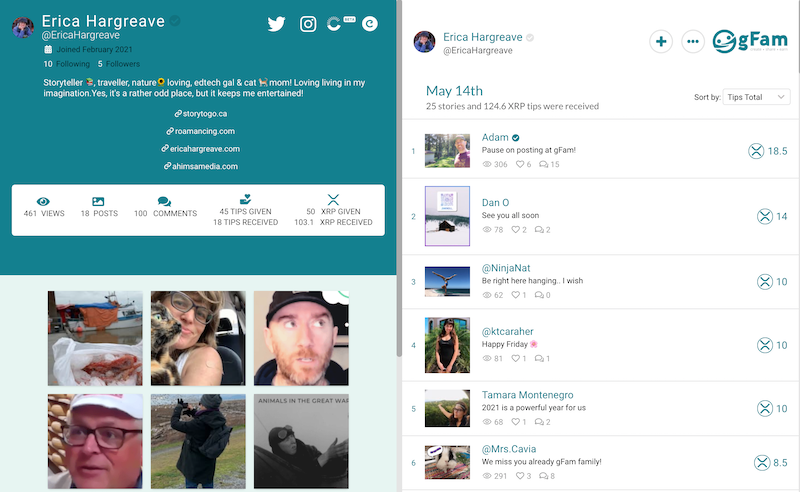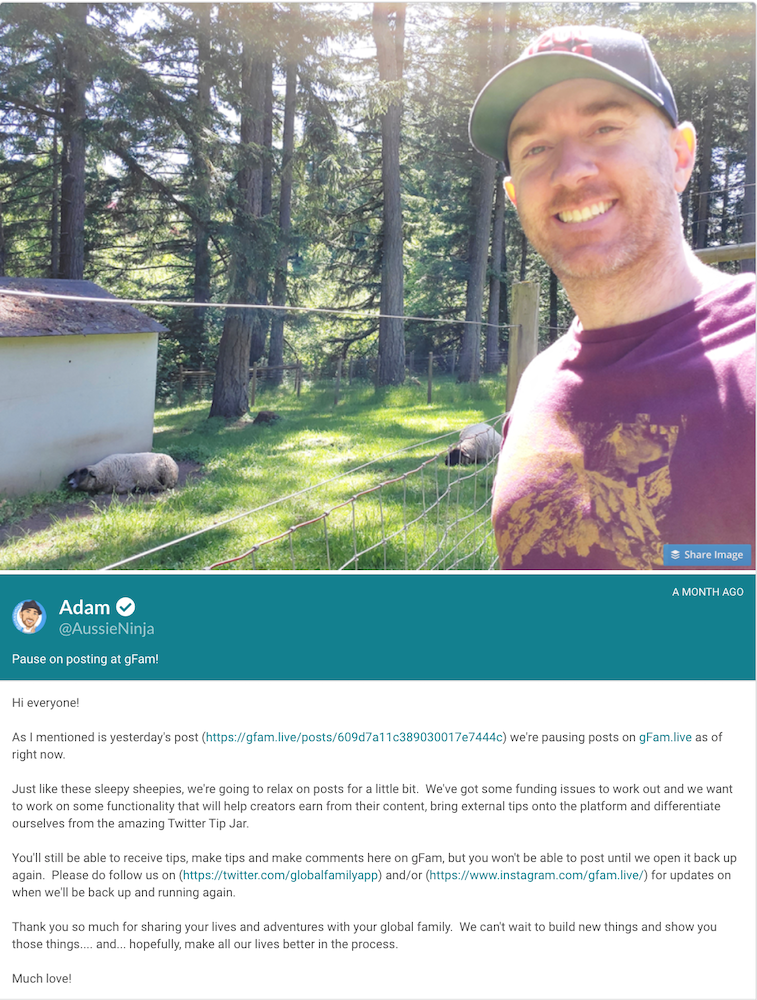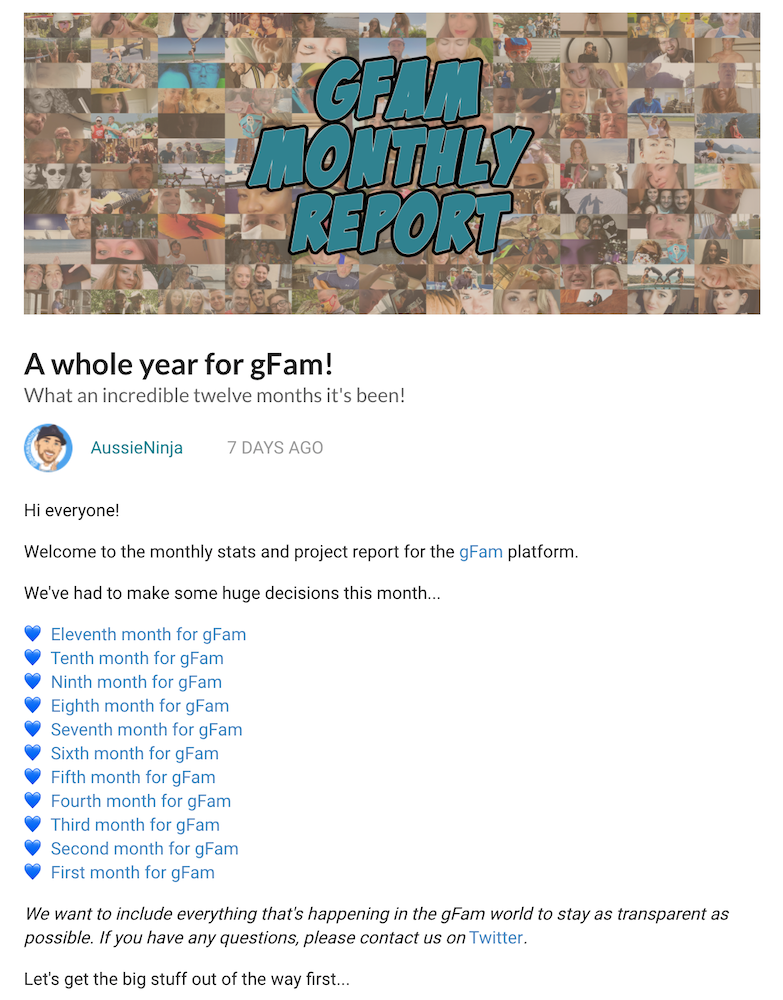With the growing ecosystem of creatives, educators and technologists building sustainability into their projects in part with the Web Monetization Standard, we have begun a series within our Sustainable Funding Series for Creatives, Educators, and Technologists exploring projects that are utilizing the Web Monetization Standard as a part of their plan. In this first interview in the series, we speak with Adam, the founder of gFam – a Web Monetized Photo Networking Platform.
Founder: Adam
Country: Australia
Interview Date: March 5, 2021
Link to the Project: https://gfam.live
Funding Method: Ingenuity, Blood-Sweat-and-Tears, Grant, Web Monetization Standard
Interview with gFam Founder, Adam
The Project : gFam Photo Networking Platform
Recognizing that there is a problem with equity in revenue models on the web, in that tech giants are receiving the majority of revenues from the time spent on content creators’ work, through advertising dollars, while the content creators themselves see little to none of these revenues, Adam set out to change this. His Goal? To help his friends that he saw had large networks of fans, but were struggling financially. From this desire to help content creators, Adam founded gFam – the global family app, which is a Web Monetized Photo Networking Platform.
Like with Instagram, gFam is a social media platform designed for the sharing of images with the ability to add text descriptions to accompany the images. The BIG difference for creators on gFam is that creators can begin earning revenue from their images starting with the first image that they share on the first day that they join the platform. Creators can earn in two different ways. Firstly gFam is Web Monetized, meaning that creators can earn using Coil by adding a payment pointer to their digital wallet. Secondly, creators can earn tips in XRP by setting up a XUMM account, linked to their gFam account. Tipping has also allowed for creators to gate specific content of theirs if they wish, only allowing access to it at a cost. If all this sounds like a foreign language to you, not to worry I elaborate on what these things are and how they work, below.
Other features of gFam include a home profile with your bio and photo stream. A lovely advantage to gFam‘s profiles over Instagram profiles, is that they allow you to add other social networking sites, as well as more than one website link. gFam’s linking abilities within post descriptions is also an advantage that gFam has over Instagram, as links that are shared in gFam post descriptions are clickable. Finally as with other social networking sites, you can follow people of interest and comment on their posts. You cannot like their posts, however. Instead the heart button is reserved for tipping. A few features that are currently missing on gFam, that I hope to see in the future, are notifications within the platform (I don’t need to be buzzed elsewhere) that let you know when someone has commented on a post of yours or replied to a comment of yours, and the ability to switch your scrolling of other people’s images between a home feed of people you are following and a global feed with everyone’s posts. I’d also like to see the image thumbnails larger, so as to better attract the eye.
What is the Web Monetization Standard?
Technically, the Web Monetization Standard is a newly proposed browser API standard that allows for the generation of a payment stream from the user directly to the website being viewed.
Basically, the Web Monetization Standard is a newer, more equitable way for creators to earn micropayments from the time that people spend on their content in the digital space.
How Does Web Monetization Work?
At present the only Web Monetization Provider utilizing the Web Monetization Standard is Coil. This means to receive micropayments via the Web Monetization Standard for time spent on your content, you need to sign up for a Coil Creator Account and set up a payment pointer with a digital wallet. I explain how to do that in this post on the Coil Web Monetization Plugin for WordPress – Set Up and Troubleshooting Issues. You might also want to consider signing up for a $5 US / month subscription with Coil to give back to the Web Monetization Community, as it is through those $5 US / month subscriptions that creators get paid. Whenever someone with a subscription spends time on your content each month, micropayments flow from the subscription to the content creator. This happens thanks to Interledger.
What is the Role of Blockchain Technology and XRP in Making Micropayments with XUMM?
As Adam explains in the video above, the advantage in the micropayments being distributed as tips via XUMM is that they utilize blockchain technology, meaning that these transactions are decentralized, fast, and don’t cost anything, so no money is lost to transaction fees. Due to there being a number of servers in the blockchain, this makes it difficult for hackers to intercept payments. Essential the framework of the blockchain prevents people from copying and pasting digital files.
XRP, which is a cryptocurrency, is used with XUMM, as it is super quick (because the blockchain is smaller and has less servers that have to agree on the transaction) and has no fees (as the servers are hosted by volunteers).
Meet Adam : the Founder of gFam
As Adam, the Founder of gFam, says he’s just a guy – a guy that saw a problem and wants to create a solution to help others, a guy who is creative and determined, a guy that sees the importance of education in growing the Web Monetization Community, and a guy that has done a lot to create a warm and supportive atmosphere in the Web Monetization space. Aside from that, Adam has been building gFam and been one of the chief cheerleaders in the Web Monetization Community, while working a day job in IT Security, being Dad to a flock of sheep, and carrying on with his passions, like Aussie Ninja Warrior.
While Adam is the Founder and Main Human at gFam, he is not the engineer of the platform, rather he has a team of technologists that he is working with on that, while he focuses on building and engaging the community.
Road to Funding Sustainably
When Adam first set out to create gFam, he was envisioning a funding model tied to banner ads, in which the content creator received 80% of the revenue from the ads and gFam received 20% of the revenue. His direction with this changed when he discovered Web Monetization as it better fits his goals, and means the platform does not become overwrought with annoying ads. With the goal of turning gFam into a Web Monetized Photo Networking Platform, Adam applied to Grant for the Web for start-up funding for the platform. He was successful in this bid, giving him the initial funds he needed to hire a team to build the platform, as well as to build and engage the community on gFam. He has openly shared his first year journey, including earnings via the Web Monetization Community Forum.
In talking to Adam about sustainability in March 2021, he at the time thought that he did not need to worry about sustainability due to the grant. Upon pushing him on this, he did concede that he would need ongoing sustainable earnings for the platform to cover server costs and ongoing work of the tech team. His thoughts were that the money earned from Web Monetization and tips would cover these costs. gFam’s Web Monetization earnings come from people scrolling through the home feed, and from time spent on creators’ content that have not enabled their own Web Monetization on their feed, and their tips come from people who tip Adam’s own posts. With the current grant having just ended, the reality has recently hit gFam that at least for the time being, other sustainable funding measures are needed to cover ongoing platform costs, beyond Web Monetization and tips. I further elaborate on this under ‘Current Challenges’ below.
Current Challenges
gFam’s biggest challenge to date have revolved around a number of challenges that the Web Monetization Community has been facing as a whole. These include:
- The fear that this is too good to be true, along with the notion that this therefore must be a scam.
- Distrust in cryptocurrency, even though you can get the digital wallet to transfer your earning into whichever currency you choose.
- Fear over opening a digital wallet.
- Feeling overwhelmed by the newer technology required to earn on gFam.
All of the above have made community building on gFam a challenge. Adam is a lovely, supportive fellow that once you get to know, you trust, but most people shy away from fear before they get to know him, and you can’t really community build around trust building from one guy, who also has many other jobs.
gFam’s other challenge at the moment is sustainable funding. With the Grant for the Web just being completed, they no longer have their main source of funding. As a result, gFam has decided to place the community on pause while they are sourcing out new funds.
This worries me for them, as:
- Communities are hard to build, and in building on a platform, they are ultimately investing their time and creativity into the platform. My fear here is putting the community on pause, stands to lose their trust, as well as their habit of visiting and utilizing the platform regularly.
- I worry that this could potentially send the wrong message to potential funders.
gFam’s reasoning in hitting pause was the server and tip costs, fear that people would stop using the platform if they were not receiving as many tips from the platform, and having the space to build in some new elements and strategize over their next steps. There was also fear over Twitter’s addition of a tip jar being competition.
Personally, I think if people leave if they are not receiving tips from you, then thats not your true community. And I think gFam is different enough from Twitter, that Twitter’s tip jar should not pose a threat.
My hope is that my fears here are unwarranted, as I want to see gFam a success. One big positive in this regard is that the Web Monetization Community is actively invested in Adam, and Adam is actively invested in the Web Monetization Community. Given this and given that we are still in the early days of fostering this community, my hope is that the community will return and gFam will continue to grow as soon as they click unpause.
Future Building
Adam’s June 2021 post, A Whole Year for gFam, speaks to what he, his team, and the gFam Community have accomplished in the past year, as well as to the current work being done while the platform is on pause to community members. This has included “creating blog posts directly on gFam.live, making gFam posts editable and deletable, cleaning up code, documenting absolutely everything, moving older images off an old cloud, creating tags so posts can be nicely shared on other social media and adding more Profile page options.
Another idea of Adam’s for the future with gFam is to work with brands on micro-motivator projects with creators, where for example a brand like Nike, gives everyone a tip who has their clothing within their content. In this model, the idea is 10,000 people could get $1 each, rather 1 influencer getting $10,000.
Looking forward to seeing both these future goals and the platform evolve, as knowing Adam, they both will.

Have a question for Adam? Ask it in the comments below, and we shall see if we can get you an answer.
An enormous thank you to Grant for the Web for funding this case study, to BCIT and Grant for the Web for funding the broader Sustainable Funding Series, to the AMTEC Trust Award and CNIE for funding my professional development work around this work, and to David Porter for acting as an advisor to me in this work.
